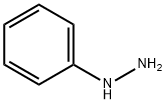100-63-0

Product Name:
Phenylhydrazine
Formula:
C6H8N2
Synonyms:
Hydrazinobenzene;Phenylhydrazine
Inquiry
CHEMICAL AND PHYSICAL PROPERTIES
| Physical Description | Phenylhydrazine appears as pale yellow crystals. Melting point 66 °F. Becomes an oily liquid. Toxic by ingestion, inhalation and skin absorption. Flash point 192 °F. Autoignition temperature 345 °F. Soluble in alcohol. |
|---|---|
| Color/Form | Monoclinic prisms or oil |
| Odor | Faint, aromatic odor. |
| Boiling Point | 471 °F at 760 mmHg (with decomposition) (USCG, 1999) |
| Melting Point | 68 °F (USCG, 1999) |
| Flash Point | 190 °F (USCG, 1999) |
| Solubility | Slight (NIOSH, 2023) |
| Density | 1.0978 (USCG, 1999) - Denser than water; will sink |
| Vapor Density | 3.7 (air= 1) |
| Vapor Pressure | 0.04 mmHg at 77 °F (NIOSH, 2023) |
| LogP | log Kow= 1.25 |
| Henry's Law Constant | Henry's Law constant = 2.9X10-8 atm-cu m/mole at 25 °C /Estimated/ |
| Autoignition Temperature | 345 °F (USCG, 1999) |
| Decomposition | When heated to decomposition it emits highly toxic fumes of /nitrogen oxides/. |
| Heat of Combustion | -875.4 kcal/g mol wt at 20 °C (solid) |
| Heat of Vaporization | 13,711.9 kcal/g mole |
| Surface Tension | 46.1 dynes/cm at 20 °C (in contact with vapor) |
| Ionization Potential | 7.64 eV |
| Refractive Index | Index of refraction: 1.60813 @ 20.3 °C/D |
| Dissociation Constants | Weak base, pK= 5.21 at 15 deg |
| Kovats Retention Index | 1157 |
| Other Experimental Properties | Conversion factors: 1 mg/l= 226 ppm; 1 ppm= 4.4 mg/cu m |
| Chemical Classes | Nitrogen Compounds -> Hydrazines |
SAFETY INFORMATION
| Signal word | Danger |
|---|---|
| Pictogram(s) |
 Skull and Crossbones Acute Toxicity GHS06  Health Hazard GHS08  Environment GHS09 |
| GHS Hazard Statements |
H315:Skin corrosion/irritation H317:Sensitisation, Skin H319:Serious eye damage/eye irritation H341:Germ cell mutagenicity H350:Carcinogenicity H372:Specific target organ toxicity, repeated exposure H400:Hazardous to the aquatic environment, acute hazard |
| Precautionary Statement Codes |
P273:Avoid release to the environment. P280:Wear protective gloves/protective clothing/eye protection/face protection. P301+P310:IF SWALLOWED: Immediately call a POISON CENTER or doctor/physician. P305+P351+P338:IF IN EYES: Rinse cautiously with water for several minutes. Remove contact lenses, if present and easy to do. Continuerinsing. |
COMPUTED DESCRIPTORS
| Molecular Weight | 108.14 g/mol |
|---|---|
| XLogP3 | 1.2 |
| Hydrogen Bond Donor Count | 2 |
| Hydrogen Bond Acceptor Count | 2 |
| Rotatable Bond Count | 1 |
| Exact Mass | 108.068748264 g/mol |
| Monoisotopic Mass | 108.068748264 g/mol |
| Topological Polar Surface Area | 38 Ų |
| Heavy Atom Count | 8 |
| Formal Charge | 0 |
| Complexity | 57.5 |
| Isotope Atom Count | 0 |
| Defined Atom Stereocenter Count | 0 |
| Undefined Atom Stereocenter Count | 0 |
| Defined Bond Stereocenter Count | 0 |
| Undefined Bond Stereocenter Count | 0 |
| Covalently-Bonded Unit Count | 1 |
| Compound Is Canonicalized | Yes |
PRODUCT INTRODUCTION
description
Phenylhydrazine appears as pale yellow crystals. Melting point 66 °F. Becomes an oily liquid. Toxic by ingestion, inhalation and skin absorption. It is an aryl hydrazine used in the investigation of oligosaccharides as well as the structure of photosystem II. It is also used in thepreparation of various dyes and pharmaceutical compounds.
RELATED SUPPLIERS
Jayaveda Globaline LLP
Mumbai
product:C6h8n2 Or C6h5nhnh2c13h11br Phenyl Hydrazine, Packaging Type: Bag
